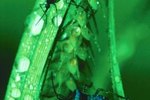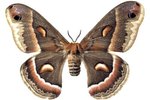
Grass on the ground, bush leaves, tree bark: all are potential spotting places for one of nature's more distinctive creatures, the fuzzy caterpillar. While many have encouraged a fuzzy little woolly bear to inch across an outstretched palm, some fuzzy bugs can cause intense reactions and should never touch human skin. Correct identification of these insect larvae can mean the difference between a ticklish time as a caterpillar treadmill and a trip to the hospital.
Woolly Bear

For many, a woolly bear is the fuzzy caterpillar – the little crawler even has his own fall festival in northeast Ohio! The woolly bear caterpillar is the larval form of an Isabella tiger moth, scientifically known as Pyrrharctia isabella, and is easily recognizable by its distinctive black-orange-black color pattern. Mythically said to predict winter's length by its interior orange band, the woolly bear emerges in fall, hibernates through winter and transforms in spring. And unlike some other fuzzy caterpillars, the woolly bear's completely safe to pick up for a closer look.
White Hickory Tussock Moth Caterpillar

In 2011, the white hickory tussock moth caterpillar gained Internet infamy after a warning circulated telling parents the black and white larva was venomous. It turned out that the warning was somewhat true – the white hickory tussock does in fact have an irritant on its sharp black hairs that sometimes leaves a rash similar to poison ivy. The caterpillar is seen July through September and overwinters inside its cocoon, which can also cause a rash if touched.
Giant Leopard Moth Caterpillar
Resembling a woolly bear without his distinctive orange band, the giant leopard moth caterpillar is the larval stage of the striking adult leopard moth, which is white with black spots like its namesake, the snow leopard. A safe caterpillar to handle, the big bug (he measures about two inches long) will roll up to reveal red bands on his skin. The giant leopard moth caterpillar is distributed widely throughout the United States.
Puss Caterpillar
The puss caterpillar is one of the fuzziest caterpillars known to man, the larval stage of a flannel moth that one might even call “furry.” Don't cuddle this bug though, as it's the most toxic caterpillar in America, causing a reaction that sends a lot of victims to the hospital. The bug carries venomous spines beneath its puffball fur, and just one touch can cause a victim to scream as full-body pain envelops them. Only rarely life-threatening, this caterpillar has nonetheless caused many adults to beg for their lives.
References
Resources
Photo Credits
-
Joseph Calev/Hemera/Getty Images
Writer Bio
Rodney Wilson is owner and manager of Goldfinch Farm in central Kentucky, where he oversees veterinary and management practices for a diverse group of animals, from dogs and cats to pigs and chickens. He's written professionally since 2001, with articles appearing in such publications as The Cincinnati Enquirer, CiN Weekly, Baby Guide and Akron Life.


